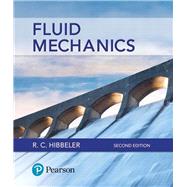Fluid Mechanics provides a comprehensive guide to a full understanding of the theory and many applications of fluid mechanics. The text features many of the hallmark pedagogical aids unique to Hibbeler texts, including its student-friendly clear organization. The text supports the development of your problem-solving skills through a large variety of problems, representing a broad range of engineering disciplines that stress practical, realistic situations encountered in professional practice and varying levels of difficulty. The text offers flexibility in that basic principles are covered in chapters 1 through 6, and the remaining chapters can be covered in any sequence without the loss of continuity.
The 2nd Edition addresses comments and suggestions from colleagues, reviewers in the teaching profession, and many of the author's students, including expanded topic coverage and new Example and Fundamental Problems intended to further your understanding of the theory and its applications.
If you are not using Mastering Engineering, you can purchase access to the videos that accompany this title here.








